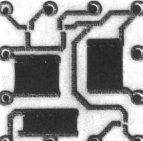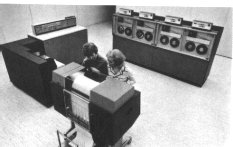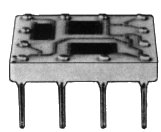|
The third generation: integrated circuits
The third calculation machines generation, about in the half of sixty, is represented by speeder, reduced dimension and cheaper machines, thanks to the integrate circuit, that rises from advanced experiments in the electronic, chemical and physical fields.
The first machines, produced by this technology were the IBM 360 series, that was able to set more than three thousand models all over the world.
The Honeywell one sets more than a thousand models of the G115 and the Univac one 2500 models of the 9000 series.
The necessary time for the operation esecution is the billionth of second, a speed about a thousand times bigger than the allowed one to the previous generation machines.
To have the idea of this extraordinary increase of the speed, it's necessary to think that a billionth of second is to second, as a second is to 30 years
This evolution needs some devices to adapt to this speed all the calculation machine members.
Between the magnetic cores memory and the central unity, that is a thousand speeder, it's created a "transit memory", it is made by very speed circuits, that allow the passage of the data.
The integrate circuit, making the miniaturist of the electric circuits, has allowed consequently to reduce the manufacture prices.
A silicon bar is cut in a lot of fine sections and on each of these, by photolithography methods, it is created some plates of few millimetre.
On each of these little plates are placed, connected among them, thousand of transistors and other electric members as resistance and diode.
The high density of the electronic members on each plate allows to obtain an high speed elaboration, a very reduced volume and a minimum waste of power.
Another important aspect of this generation machines concerns the development of compatible programs among the different families of calculation machines.
The calculation machines are projected to be powered along the time, increasing their capacity thanks to some modules that allow to conform the machine every type of application and information volume to elaborate.
By the third generation some previous limits are overcome because the calculation machines were generally built with the right size, they were projected through a specific dimension to have a scientific and commercial use.
To manage and to co-ordinate the various calculation machines members, some programs are created and their aims is that to increase the machine efficiency without having any specific task..
The "Operating System" arises and it verifies the machine's work without the operator intervention and eliminating so the time-waiting.
Further the operating system, there are new programming languages as the APL (A Programming Language) that is used to question the calculation machine, the PL/1 (Programming Language 1) that is a versatile language and it solves both scientific and commercial problems; there is also the BASIC ( Beginners All Purpose Symbolic Instruction Code) that makes easy to approach the programming to the inexperienced users.
These new languages are developed according to the new "multiprogramming" and "time sharing" concepts that really allow to elaborate more programs at the same time allowing so the simultaneous use of the calculation machine by more users.
Under the power of the operating system the machine goes from an user to another one in a very rapid way in comparison to the speed of the terminal ones that nobody understands to use the calculation machine together with other ones.
The operating system, using better the calculation machine allows to various programs, that are introduced into the central memory, to work at the same time using all the dead times during the execution of the other programs.
|
















